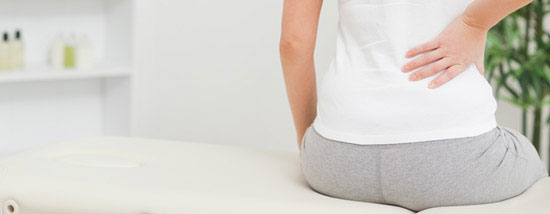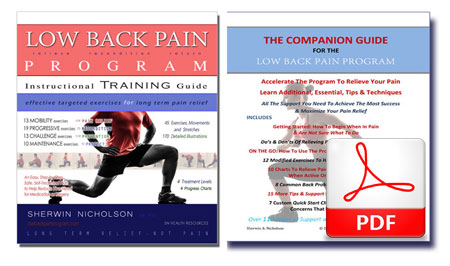Why It Hurts When You Sit & What You Should Do
By Sherwin Nicholson | Updated May 7, 2020

If your back hurts when you sit, here is a solution
For most of us, we must sit for many hours. And if you don’t have the time to stand up and move around, you need some help. But first, please take the time to learn about the negative effects of sitting.
If you have more than just minor discomfort, both rest and medication are no longer effective. You need to make some serious changes with your lifestyle. This is even more important if you sit for extended periods of time.
Did you really say ‘serious’?
Yes! It is that serious. Don’t ignore the symptoms. Sitting is now officially considered one of top health risks in our society for your back. It’s also one of the worst habits to avoid because our livelihoods depend on it.
Most likely you have said at least at one time: “My back hurts when I’m in the office for a long time”. So it’s is well worth the time and effort to learn about what is going on with your body while you’re at your desk or driving.
If you need any help with your discomfort because you sit all day in an office chair, follow these 5 important tips.
The Main Culprits
Your longer working hours, physically demanding careers, intense activities, traveling longer distances and extended time on the chair, is worsening your pain and has ultimately become a chronic issue.
The most common times are at the office, driving & on the ‘screens.’ As much as we feel that we are more productive in our lives and for the sake of others, there is a physical cost for it every time.
If it hurts when you’re at work or driving, then you should learn how this simple technique can help you when it hurts to sit.
If you need any help with your discomfort because you sit all day in an office chair, follow these 5 important tips.
The Effect on Your Body
When you stand, the extrinsic and intrinsic muscles of your spine (along with the abdominal muscles) regularly contract and relax to maintain your posture, neutral curve, and natural pelvic tilt.
These muscles consist of all of the muscles of your spine from the pelvis to the base of your skull. It is the deeper, smaller and less visible intrinsic muscles that run along your entire spine and make several adjustments and corrections while you stand to maintain your posture and balance.
As you are seated, there is a significant change in the need for these muscles to give support. When seated with a lumbar support, the intrinsic and abdominal muscles are no longer active. They cease to support your spine as it rests.
Lumbar supports on a chair are generally a bad idea as they only encourage you to relax when upright. This can cause you pain. They encourage you to lose active support from your muscles and to be less likely to remain upright.
While a seat can seem like a preferred alternative to standing, it has its risk.
Without adequate lumbar support from these muscles, your neutral curve is lost, causing disc imbalance. Here, your upper body weight bears down on your lower discs while unsupported.
Weight on each disc becomes uneven, and disc bulge occurs. The extrinsic and intrinsic muscles (which are smaller and shorter) become weaker and overstretched. Using the lumbar support found in all chairs also reduces circulation to these muscles as you lay against them.
Poor Mechanics Affect the Muscles that Protect You
Most of us do not use our chairs upright properly, and over time, may slouch while seated. Here the pelvis develops a posterior tilt, leading to greater disc imbalance and risk or injury.
Placing our arms and hands on the table, keyboard or steering wheel, for example, allows us to relax our upper body further. Relaxing exacerbates the curve in our spine as we bear down more of the weight of our upper body. Our natural and balanced lumbar S-shaped curve becomes a C-shaped curve.
Other muscles like the abdominals and the transverse abdominus relax, resulting in less support. Hamstring and quadricep muscles become progressively shorter (and weaker). The progression causes them to pull on the pelvis during activity, thereby reducing our pelvic mobility.
With less pelvic mobility, the lower back compensates by bending and moving more than needed when we are engaged in daily activity.
The effects of neglect
Relying on a chair for long periods of time, leads to shortened hip flexors, especially our psoas muscles. This muscle attaches from your femur to your lumbar spine and shortens. A tight psoas is a well-known contributor to pain.
A known condition called Adaptive Shortening Syndrome happens where muscles chronically shorten and weaken, making standing and sitting both painful. If your work keeps you in this position, you most likely are suffering from this condition.
The discomfort felt from these tight muscles are more noticeable while standing or actively moving. Muscles tend to shorten when either underused or overused. It is rare that they will return to their original, desired length unless you adopt a safe practice for stretching them.
Without adequate treatment, this discomfort may cause some to rely on the use of medication, poor stretching, unhelpful exercises, or merely to accept the discomfort as minor and tolerable. If there is no change to these habits, the muscles and discs will continue to bear this load and suffer, leading to chronic pain that is difficult to manage.
If it does become difficult to manage, you may end up with radicular pain such as with sciatica so it is important to spot any symptoms.
Your chair may provide needed relief, but it is important to be self-aware about the effect it has on you.
Tips: What you can do about it.
10 Exercise Tips Everyone Should Follow To Maintain A Healthy Back
By altering our habits and following these 10 exercise tips to become better physically conditioned, you’ll reduce or minimize your discomfort and risk of lumbar injury. Pain can be reduced or eliminated by following many specific stretches and exercises.
Begin by following this stretch exercise whenever you feel discomfort. You can do it anywhere when seated easily for 1 minute per side for every 30 minutes of sitting.
Download and get started with an easy to follow, affordable, instructional guide for relief. It will help you with both your pain and many other mechanical causes.
“All of the exercises are simple and quick, and I can complete them at work while sitting. Overall this is a good book to read if you truly are interested in exercises to help you.”
“I started noticing a difference in my back within three days.”
Don’t just stop at this article. There’s more ways to help:
Exercises that will help you whenever you’re seated
Is your chair causing Adaptive Shortening (Ouch!)
Don’t let your job (of sitting) ruin your life
Try this simple piriformis stretch to help you
References:
www.spine-health.com/conditions/lbp
Herniated disc/Slipped Disk-http://www.ncbi.nlm.nih.gov/pubmedhealth/PMH0001478/
Chronic lbp and its association with lumbar vertebrae and intervertebral disc changes in adults. A case control study. – Karunanayake AL1, Pathmeswaran A2, Wijayaratne LS3. Int J Rheum Dis. 2017 Feb 16. doi: 10.1111/1756-185X.13026

